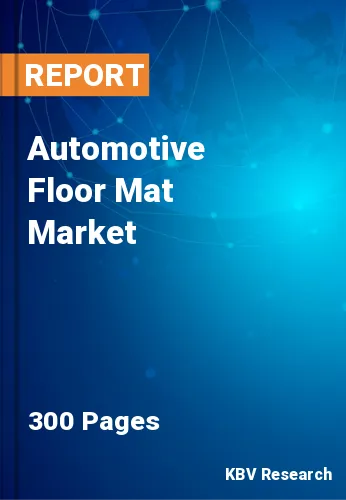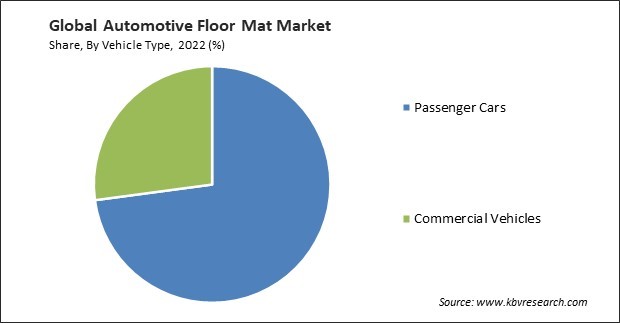
The Global Automotive Floor Mat Market size is expected to reach $15.8 billion by 2030, rising at a market growth of 4.4% CAGR during the forecast period. In the year 2022, the market attained a volume of 2,36,105.6 thousand units, experiencing a growth of 3.4% (2019-2022).
Aftermarket suppliers often lead the way in introducing innovative features and materials in floor mats. Therefore, the Aftermarket segment acquired $3,486.9 million in 2022. This can include advancements such as all-weather resistance, built-in technology, or eco-friendly materials. Consumers seeking the latest advancements turn to the aftermarket for cutting-edge floor mat options. Customers preferences and trends change over time. Aftermarket suppliers are agile and responsive to these changes, offering floor mat options that align with evolving consumer demands, whether related to sustainability, technology integration, or design aesthetics. As a result, aftermarket opportunities have positively impacted the market. Some of the factors impacting the market are growing demand for eco-friendly and sustainable materials, expansion of the automotive industry, and changes in the price of raw materials and seasonal demand.

A rising understanding of environmental issues has led consumers to seek products that align with their sustainability values. As individuals become more environmentally conscious, there is a growing preference for automotive accessories, including floor mats, manufactured using eco-friendly materials and processes. Automotive manufacturers and suppliers increasingly adopt corporate sustainability initiatives as part of their business strategies. This includes incorporating sustainable materials in various components, such as floor mats, to lower their carbon footprint and contribute to a more endurable supply chain. The manufacturers are increasingly collaborating with suppliers specializing in sustainable materials. These partnerships facilitate access to innovative eco-friendly materials and support a more sustainable and responsible supply chain. Additionally, an increase in vehicle sales often characterizes the growth of the automotive industry. As more cars, trucks, and other vehicles are sold globally, the demand for accessories like floor mats rises proportionally. New vehicle owners often seek to personalize and protect their vehicles. The automotive industry encompasses various vehicle types, including passenger cars, SUVs, trucks, and commercial vehicles. The production and sales growth across these segments result in a higher demand for various floor mat options tailored to different vehicle models and sizes. The expansion of the automotive industry creates significant opportunities in the aftermarket segment. Vehicle owners, including those with older models, often turn to aftermarket accessories, such as floor mats, for replacement or customization. This innovation caters to consumer preferences for stylish, functional, and durable accessories. Therefore, the expansion of the automotive industry creates a favorable environment for the market.
However, when the prices of raw materials, such as rubber, polymers, or fibers, experience fluctuations, it can lead to cost pressures on manufacturers. Sudden increases in raw material prices may result in higher production costs for automotive floor mats, squeezing profit margins. The automotive industry operates on long planning and production cycles. Fluctuations in raw material prices can disrupt the planning process, making it challenging for manufacturers to predict and control costs effectively. This uncertainty can lead to difficulties in setting competitive prices for floor mats. Overreliance on distinct seasons can make the market vulnerable to economic downturns or unexpected disruptions, impacting overall revenue and profitability. Thus, the above-mentioned factors will cause the market growth to decline.
On the basis of vehicle type, the market is segmented into passenger cars and commercial vehicles. The commercial vehicles segment acquired a substantial revenue share in the market in 2022. Commercial vehicles are subjected to heavy use and various cargo loading and unloading types. Automotive floor mats made from durable materials, such as heavy-duty rubber or all-weather materials, can withstand the rigors of commercial applications, ensuring longevity and cost-effectiveness. Commercial vehicles such as pickup trucks, vans, and buses are often subjected to heavy use and high traffic. These mats help protect the vehicle's interior from dust and debris and reduce maintenance costs. Moreover, commercial vehicles have longer working hours and higher mileage than passenger vehicles. As a result, they require a durable, non-slip mat that can withstand heavy use, thereby driving the demand for mats in commercial vehicles.

By sales channel, the market is classified into OEM and aftermarket. In 2022, the OEM segment registered the highest revenue share in the market. OEMs play a vital role in the market by working closely with automakers during the vehicle design phase. Floor mats are integrated into the overall interior design of the vehicle, ensuring a seamless fit and alignment with the manufacturer's aesthetic and functional specifications. OEMs are integrated into the supply chain of the automotive industry. They work closely with automakers to ensure timely and efficient delivery of floor mats for inclusion in the production of new vehicles. This integration helps streamline the overall manufacturing process.
Based on material, the market is fragmented into rubber, textile, and polymer. In 2022, the rubber segment held the highest revenue share in the market. Rubber floor mats are comfortable to clean and maintain. Most dirt, mud, and spills can be quickly wiped or hosed off, making them a practical choice for vehicle owners who prioritize easy maintenance. This is especially beneficial for commercial vehicles that may experience frequent messes. Rubber mats are naturally resistant to stains. They repel liquids and prevent them from seeping into the mat, making them effective at protecting the vehicle's interior from spills and stains caused by food, beverages, or other substances. Rubber mats have inherent sound-dampening properties that help reduce road noise and vibrations. This feature contributes to a quieter and more comfortable cabin environment, enhancing the overall driving experience for occupants.
| Report Attribute | Details |
|---|---|
| Market size value in 2022 | USD 10.9 Billion |
| Market size forecast in 2030 | USD 15.8 Billion |
| Base Year | 2022 |
| Historical Period | 2019 to 2021 |
| Forecast Period | 2023 to 2030 |
| Revenue Growth Rate | CAGR of 4.4% from 2023 to 2030 |
| Number of Pages | 300 |
| Number of Table | 650 |
| Quantitative Data | Volume in Thousand Units, Revenue in USD Billion, and CAGR from 2019 to 2030 |
| Report coverage | Market Trends, Revenue Estimation and Forecast, Segmentation Analysis, Regional and Country Breakdown, Porter’s 5 Forces Analysis, Company Profiling, Companies Strategic Developments, SWOT Analysis, Winning Imperatives |
| Segments covered | Material, Vehicle Type, Sales Channel, Region |
| Country scope |
|
| Companies Included | 3M Company, Lear Corporation, Husky Liners, Inc. (RealTruck Group, Inc.), Thermoflex Corporation, Racemark International LLC, Maxliners (Vandapac Co., Ltd.), Covercraft Industries LLC (Audax Management Company, LLC), Auto Custom Carpet, Inc., Suminoe Textile Co., Ltd., and Toyota Boshoku Corporation (Toyota Motor Corporation) |
| Growth Drivers |
|
| Restraints |
|
Region-wise, the market is analyzed across North America, Europe, Asia Pacific, and LAMEA. In 2022, the Asia Pacific region generated the largest revenue share in the market. Countries including India, China, South Korea, and Japan are witnessing significant growth in vehicle ownership owing to rising urbanization and disposable income. As more people own vehicles, the demand for vehicle accessories such as floor mats will likely increase. Moreover, Asia Pacific has diverse climate zones, creating demand for specialized mats such as all-weather or heavy-duty floor mats. The availability of aftermarket accessories through various retail channels, including online platforms, makes it easier for customers to purchase floor liners and mats, further boosting the demand.
Free Valuable Insights: The Global Automotive Floor Mat Market size to reach USD 15.8 Billion by 2030
The market research report covers the analysis of key stakeholders of the market. Key companies profiled in the report include 3M Company, Lear Corporation, Husky Liners, Inc. (RealTruck Group, Inc.), Thermoflex Corporation, Racemark International LLC, Maxliners (Vandapac Co., Ltd.), Covercraft Industries LLC (Audax Management Company, LLC), Auto Custom Carpet, Inc., Suminoe Textile Co., Ltd., and Toyota Boshoku Corporation (Toyota Motor Corporation)
By Material (Volume, Thousand Units, USD billion, 2019-2030)
By Vehicle Type (Volume, Thousand Units, USD billion, 2019-2030)
By Sales Channel (Volume, Thousand Units, USD billion, 2019-2030)
By Geography (Volume, Thousand Units, USD billion, 2019-2030)
This Market size is expected to reach $15.8 billion by 2030.
Growing demand for eco-friendly and sustainable materials are driving the Market in coming years, however, Changes in the price of raw materials and seasonal demand restraints the growth of the Market.
3M Company, Lear Corporation, Husky Liners, Inc. (RealTruck Group, Inc.), Thermoflex Corporation, Racemark International LLC, Maxliners (Vandapac Co., Ltd.), Covercraft Industries LLC (Audax Management Company, LLC), Auto Custom Carpet, Inc., Suminoe Textile Co., Ltd., and Toyota Boshoku Corporation (Toyota Motor Corporation)
In the year 2022, the market attained a volume of 2,36,105.6 thousand units, experiencing a growth of 3.4% (2019-2022).
The Passenger Cars segment is leading the Market, By Vehicle Type in 2022; thereby, achieving a market value of $10.9 billion by 2030.
The Asia Pacific region dominated the Market, By Region in 2022, and would continue to be a dominant market till 2030; thereby, achieving a market value of $6.2 billion by 2030.
Our team of dedicated experts can provide you with attractive expansion opportunities for your business.
